Abstract
The sexual agglutinins of the budding yeasts are cell adhesion proteins that promote aggregation of cells during mating. In each yeast species, complementary agglutinins are expressed by cells of opposite mating type that interact to mediate aggregation. Saccharomyces cerevisiae alpha-agglutinin and its analogs from other yeasts are single-subunit glycoproteins that contain N-linked and O-linked oligosaccharides. The N-glycosidase-sensitive carbohydrate is not necessary for activity. The proposed binding domain of alpha-agglutinin has features characteristic of the immunoglobulin fold structures of cell adhesion proteins of higher eukaryotes. The C-terminal region of alpha-agglutinin plays a role in anchoring the glycoprotein to the cell surface. The S. cerevisiae alpha-agglutinin and its analogs from other species contain multiple subunits; one or more binding subunits, which interact with the opposite agglutinin, are disulfide bonded to a core subunit, which mediates cell wall anchorage. The core subunits are composed of 80 to 95% O-linked carbohydrate. The binding subunits have less carbohydrate, and both carbohydrate and peptide play roles in binding. The alpha-agglutinin and alpha-agglutinin genes from S. cerevisiae have been cloned and shown to be regulated by the mating-type locus, MAT, and by pheromone induction. The agglutinins are necessary for mating under conditions that do not promote cell-cell contact. The role of the agglutinins therefore is to promote close interactions between cells of opposite mating type and possibly to facilitate the response to phermone, thus increasing the efficiency of mating. We speculate that they mediate enhanced response to sex pheromones by providing a synapse at the point of cell-cell contact, at which both pheromone secretion and cell fusion occur.
Full text
PDF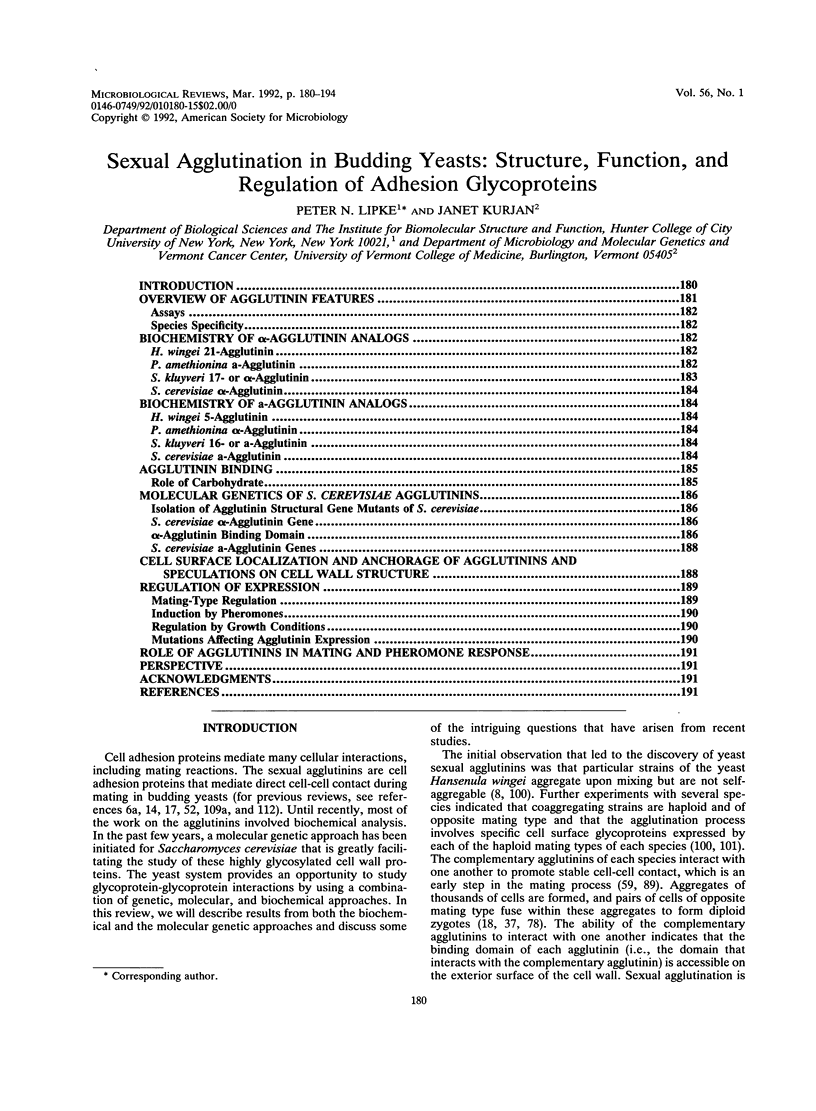
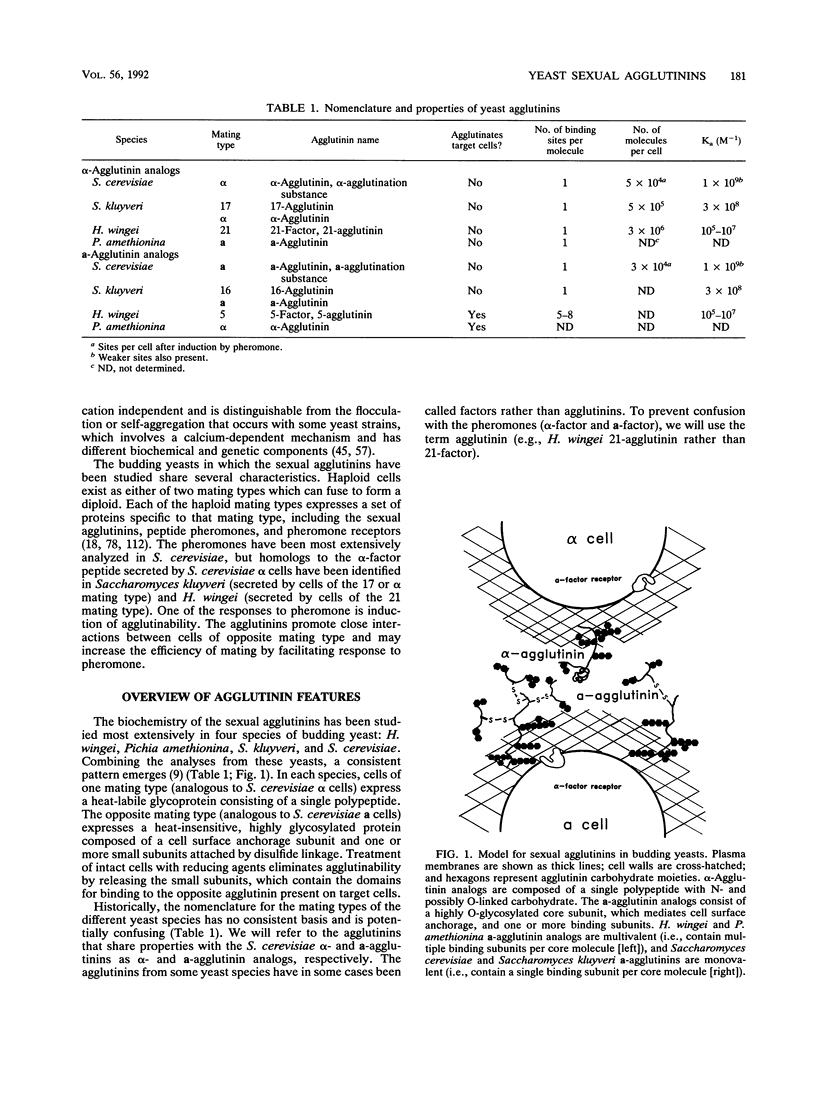
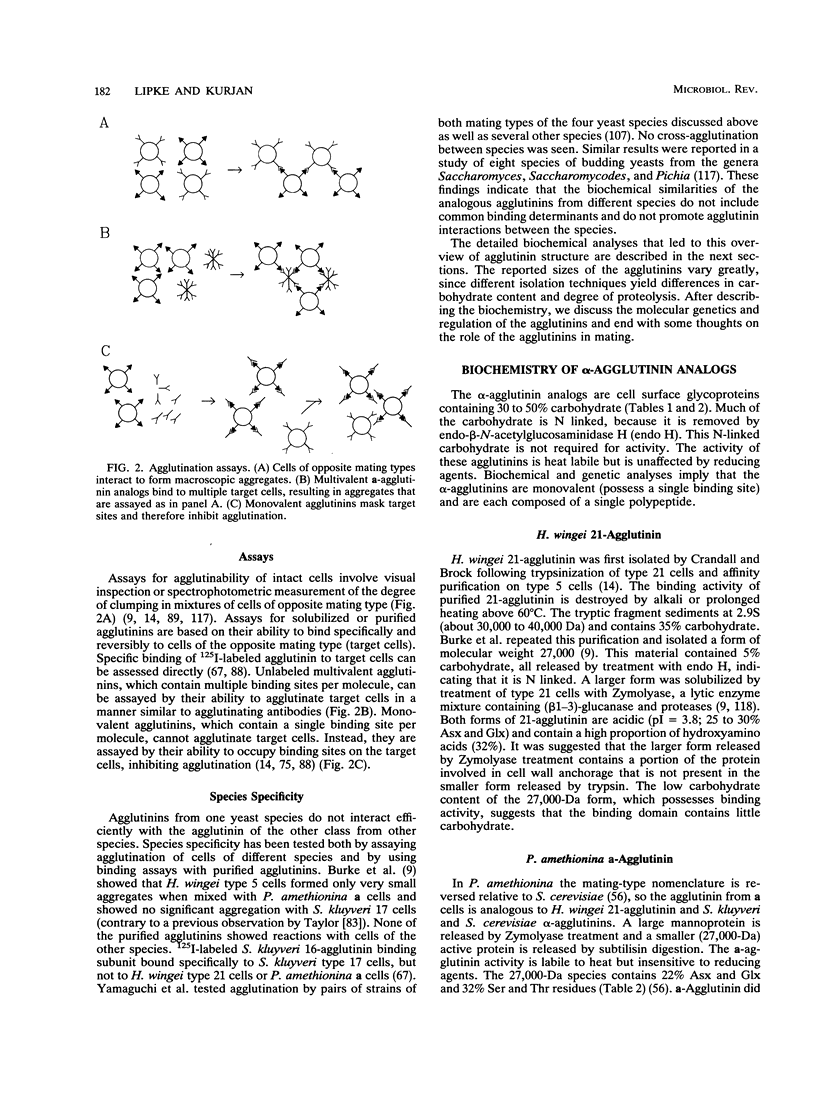
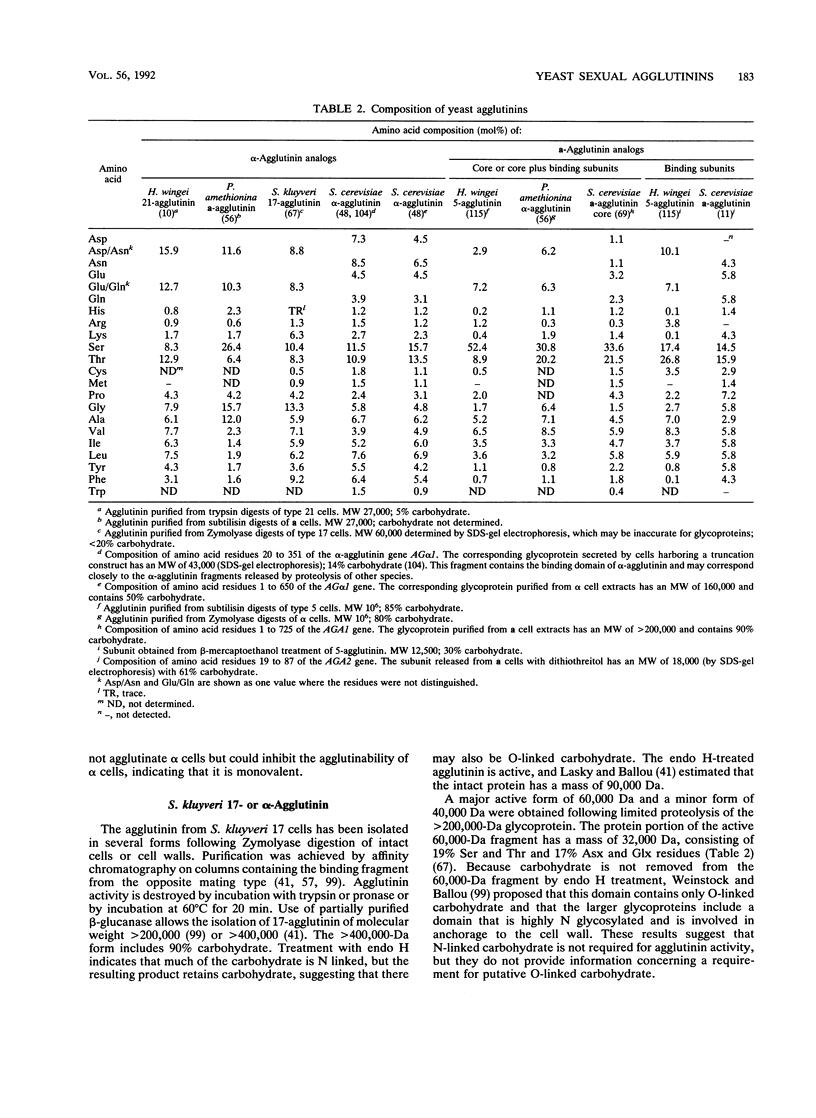
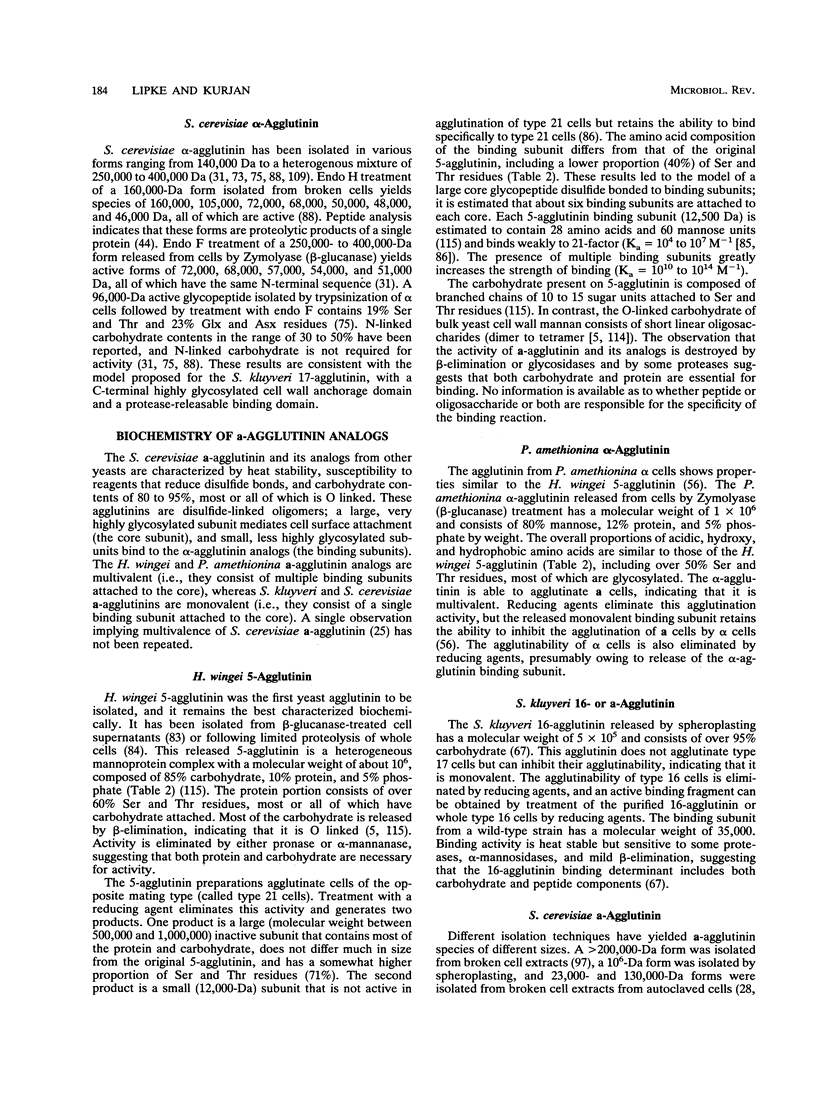
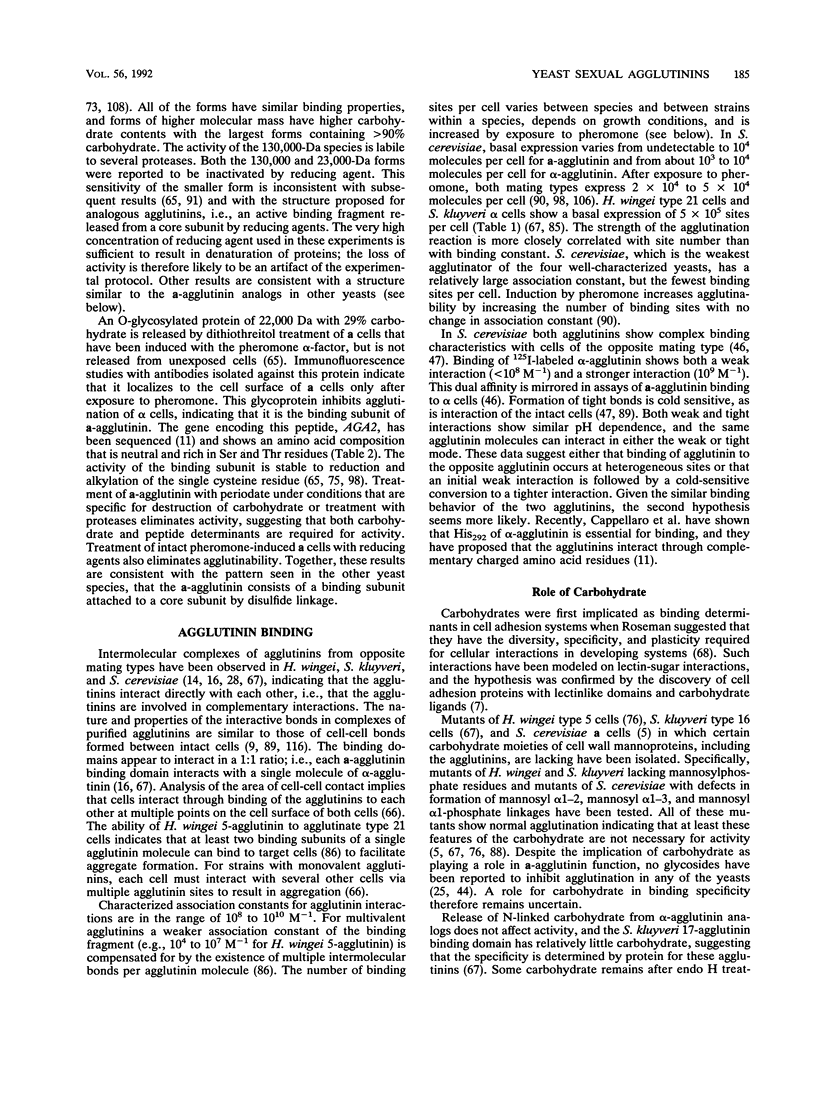
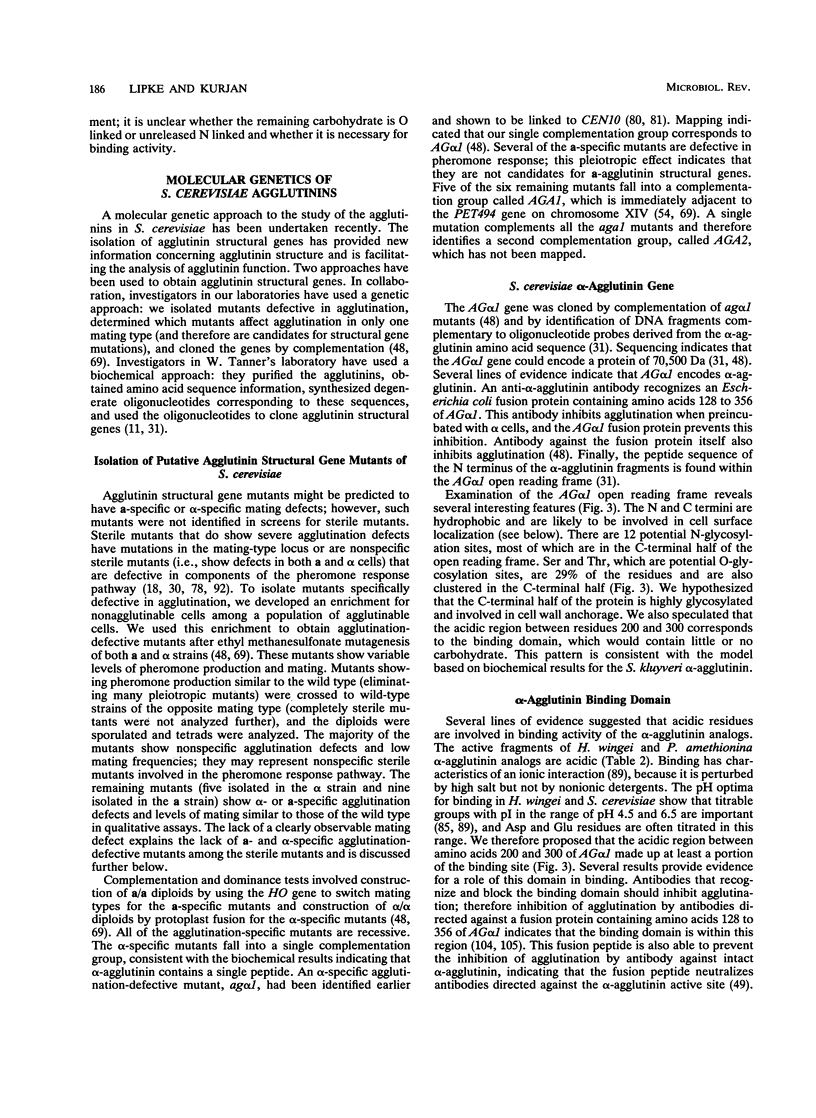
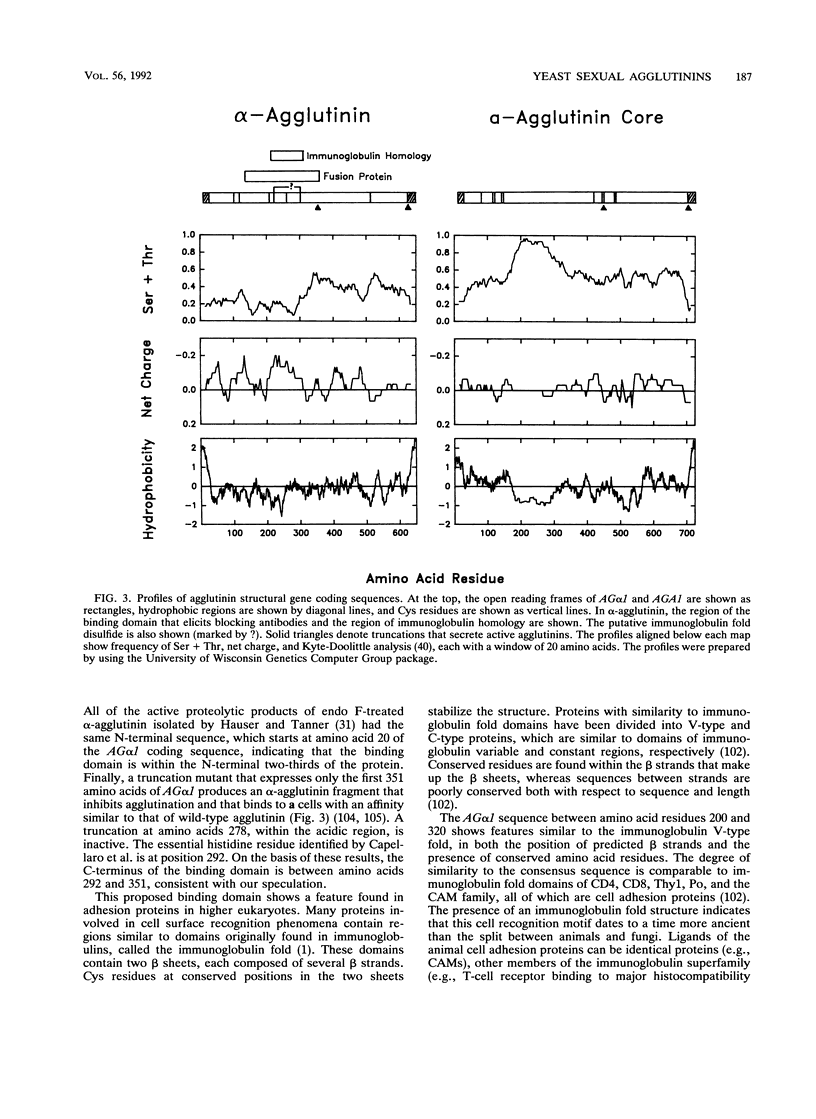
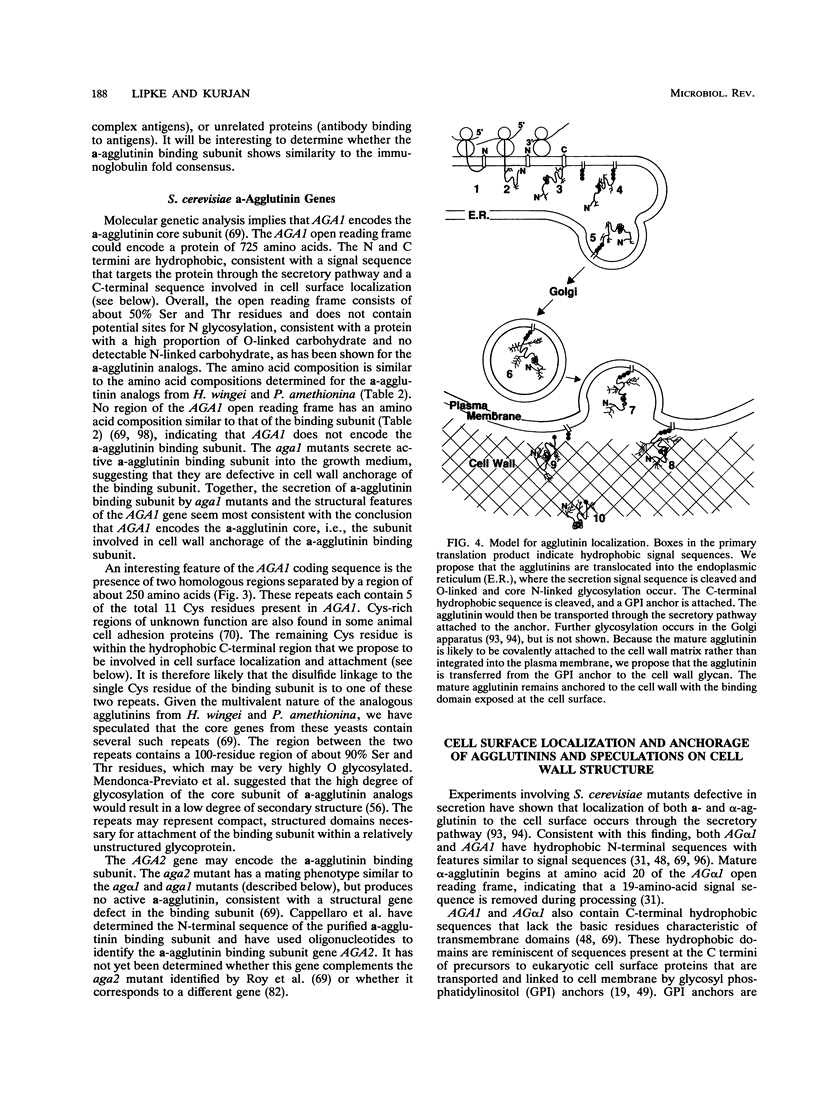
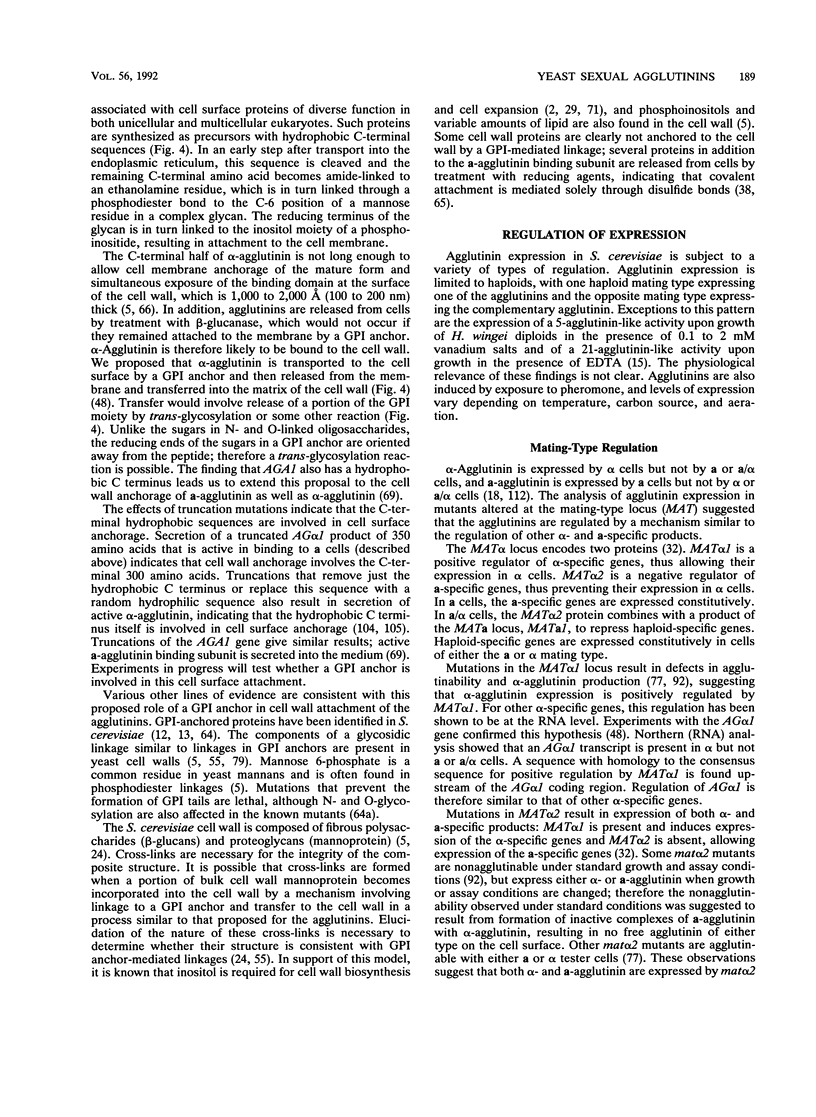
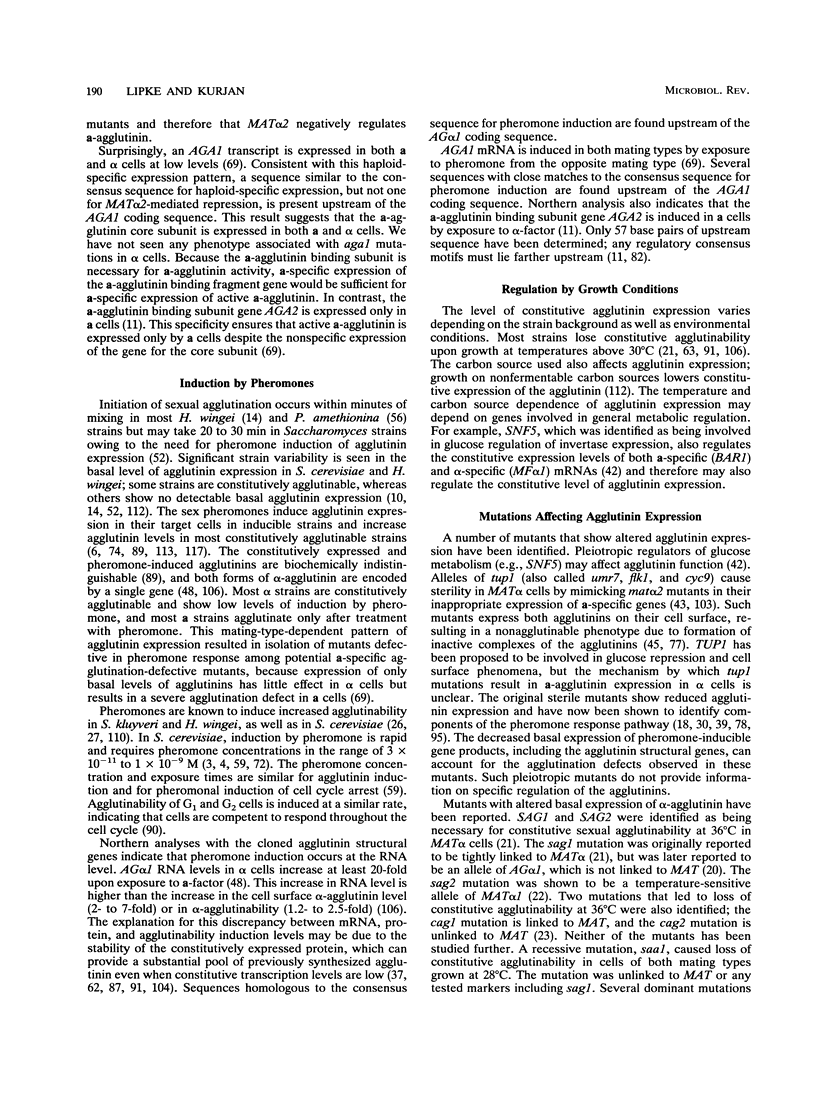
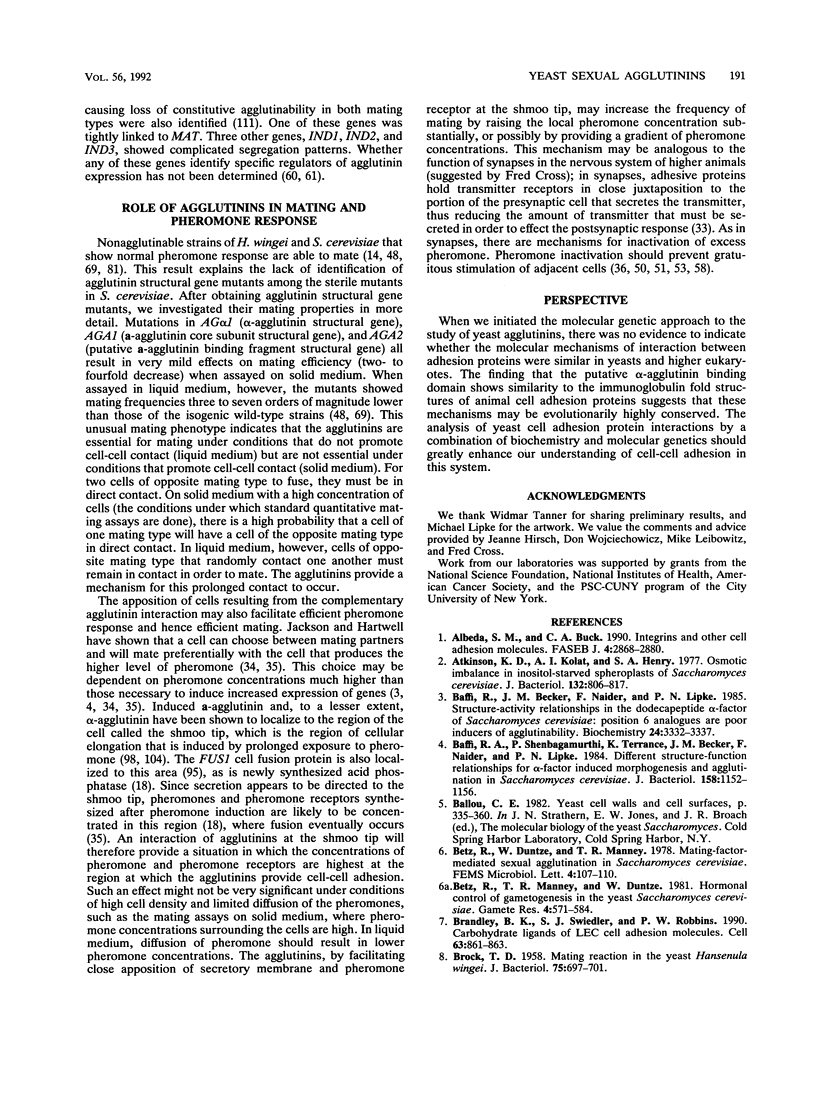
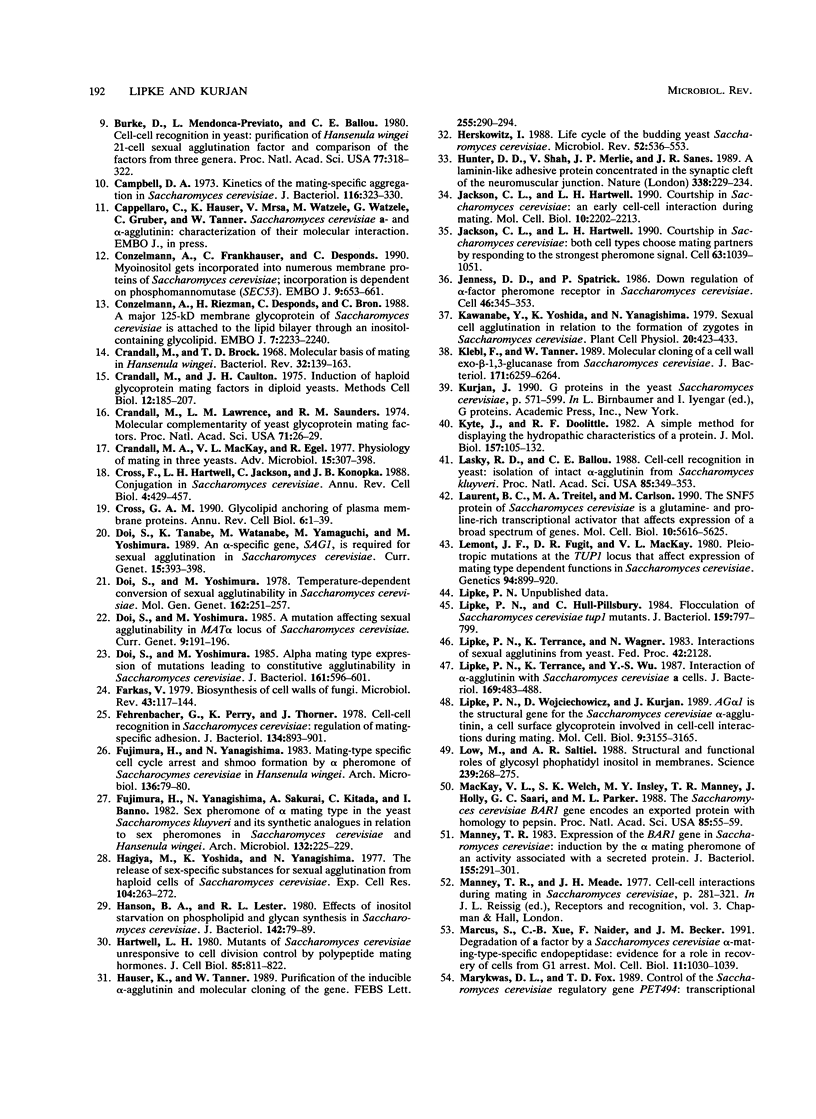
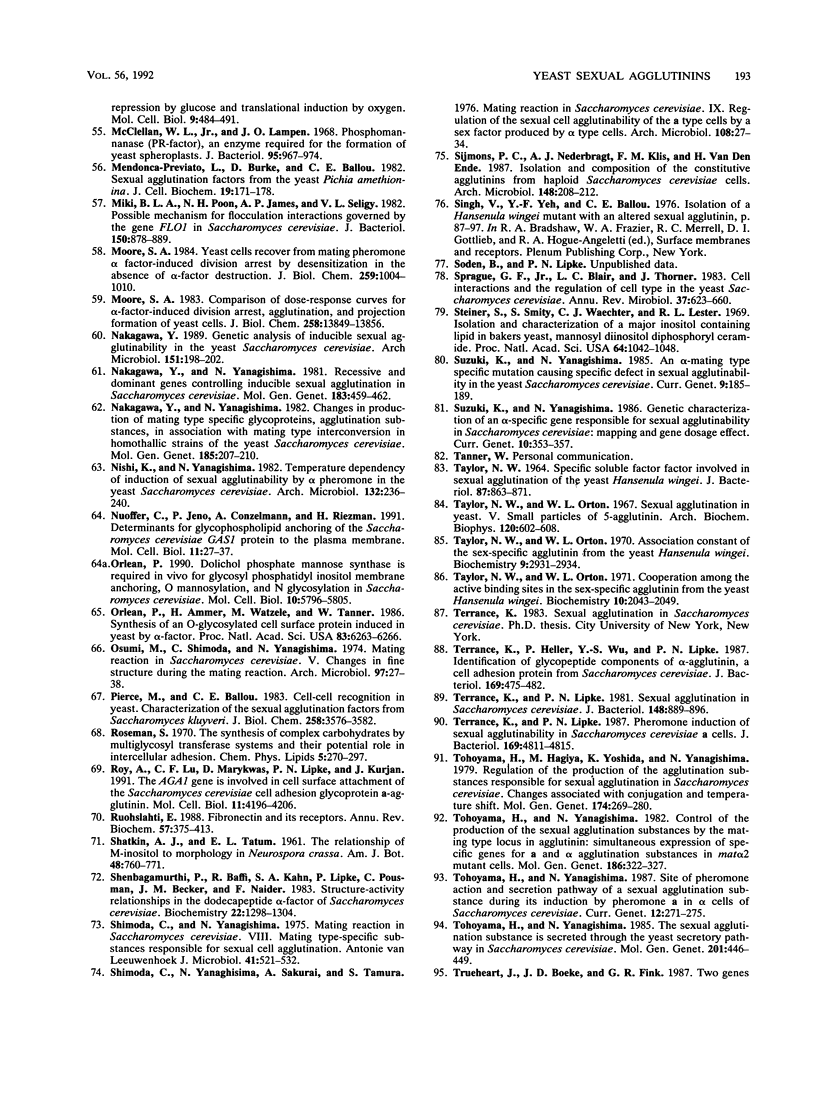
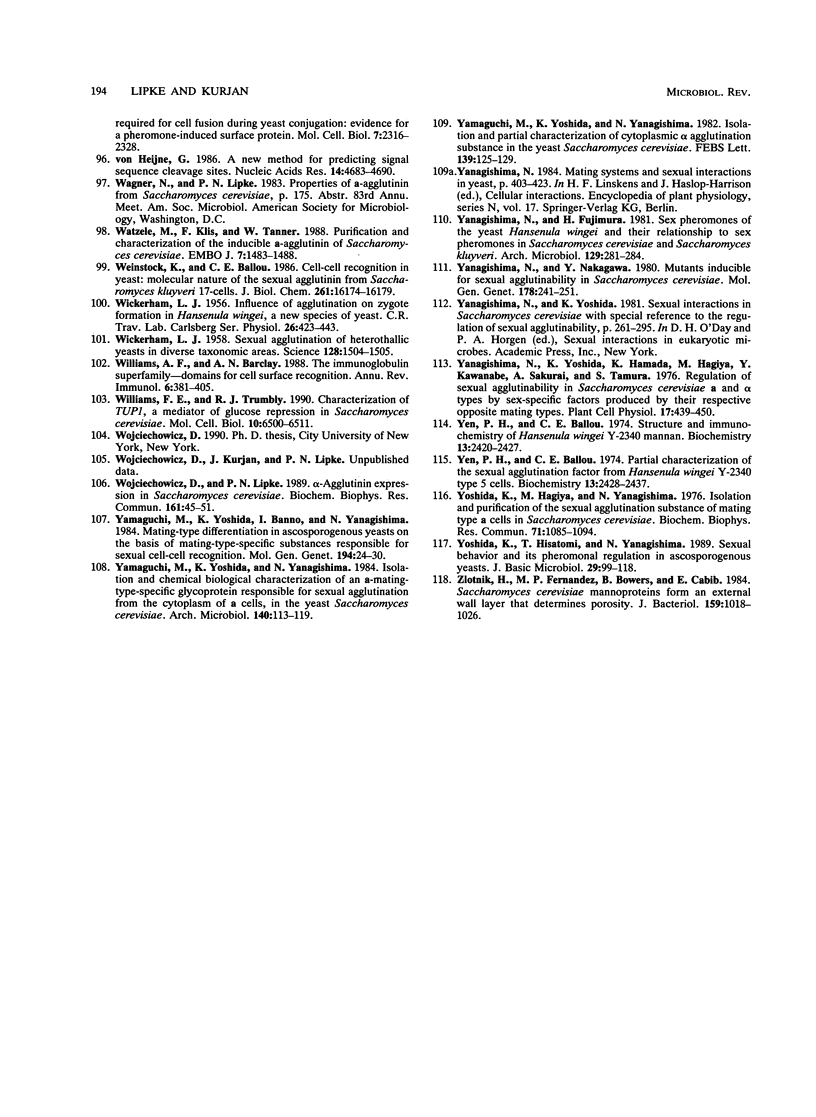
Selected References
These references are in PubMed. This may not be the complete list of references from this article.
- Albelda S. M., Buck C. A. Integrins and other cell adhesion molecules. FASEB J. 1990 Aug;4(11):2868–2880. [PubMed] [Google Scholar]
- Atkinson K. D., Kolat A. I., Henry S. A. Osmotic imbalance in inositol-starved spheroplasts of Saccharomyces cerevisiae. J Bacteriol. 1977 Dec;132(3):806–817. doi: 10.1128/jb.132.3.806-817.1977. [DOI] [PMC free article] [PubMed] [Google Scholar]
- BROCK T. D. Mating reaction in the yeast Hansenula wingei; preliminary observations and quantitation. J Bacteriol. 1958 Jun;75(6):697–701. doi: 10.1128/jb.75.6.697-701.1958. [DOI] [PMC free article] [PubMed] [Google Scholar]
- Baffi R. A., Becker J. M., Lipke P. N., Naider F. Structure-activity relationships in the dodecapeptide alpha-factor of Saccharomyces cerevisiae: position 6 analogues are poor inducers of agglutinability. Biochemistry. 1985 Jun 18;24(13):3332–3337. doi: 10.1021/bi00334a038. [DOI] [PubMed] [Google Scholar]
- Baffi R. A., Shenbagamurthi P., Terrance K., Becker J. M., Naider F., Lipke P. N. Different structure-function relationships for alpha-factor-induced morphogenesis and agglutination in Saccharomyces cerevisiae. J Bacteriol. 1984 Jun;158(3):1152–1156. doi: 10.1128/jb.158.3.1152-1156.1984. [DOI] [PMC free article] [PubMed] [Google Scholar]
- Brandley B. K., Swiedler S. J., Robbins P. W. Carbohydrate ligands of the LEC cell adhesion molecules. Cell. 1990 Nov 30;63(5):861–863. doi: 10.1016/0092-8674(90)90487-y. [DOI] [PubMed] [Google Scholar]
- Burke D., Mendonça-Previato L., Ballou C. E. Cell-cell recognition in yeast: purification of Hansenula wingei 21-cell sexual agglutination factor and comparison of the factors from three genera. Proc Natl Acad Sci U S A. 1980 Jan;77(1):318–322. doi: 10.1073/pnas.77.1.318. [DOI] [PMC free article] [PubMed] [Google Scholar]
- Campbell D. A. Kinetics of the mating-specific aggregation in Saccharomyces cerevisiae. J Bacteriol. 1973 Oct;116(1):323–330. doi: 10.1128/jb.116.1.323-330.1973. [DOI] [PMC free article] [PubMed] [Google Scholar]
- Conzelmann A., Fankhauser C., Desponds C. Myoinositol gets incorporated into numerous membrane glycoproteins of Saccharomyces cerevisiae; incorporation is dependent on phosphomannomutase (sec53). EMBO J. 1990 Mar;9(3):653–661. doi: 10.1002/j.1460-2075.1990.tb08157.x. [DOI] [PMC free article] [PubMed] [Google Scholar]
- Conzelmann A., Riezman H., Desponds C., Bron C. A major 125-kd membrane glycoprotein of Saccharomyces cerevisiae is attached to the lipid bilayer through an inositol-containing phospholipid. EMBO J. 1988 Jul;7(7):2233–2240. doi: 10.1002/j.1460-2075.1988.tb03063.x. [DOI] [PMC free article] [PubMed] [Google Scholar]
- Crandall M. A., Brock T. D. Molecular basis of mating in the yeast hansenula wingei. Bacteriol Rev. 1968 Sep;32(3):139–163. doi: 10.1128/br.32.3.139-163.1968. [DOI] [PMC free article] [PubMed] [Google Scholar]
- Crandall M., Caulton J. H. Induction of haploid glycoprotein mating factors in diploid yeasts. Methods Cell Biol. 1975;12:185–207. doi: 10.1016/s0091-679x(08)60957-7. [DOI] [PubMed] [Google Scholar]
- Crandall M., Egel R., Mackay V. L. Physiology of mating in three yeasts. Adv Microb Physiol. 1977;15:307–398. doi: 10.1016/s0065-2911(08)60319-7. [DOI] [PubMed] [Google Scholar]
- Crandall M., Lawrence L. M., Saunders R. M. Molecular complementarity of yeast glycoprotein mating factors. Proc Natl Acad Sci U S A. 1974 Jan;71(1):26–29. doi: 10.1073/pnas.71.1.26. [DOI] [PMC free article] [PubMed] [Google Scholar]
- Cross F., Hartwell L. H., Jackson C., Konopka J. B. Conjugation in Saccharomyces cerevisiae. Annu Rev Cell Biol. 1988;4:429–457. doi: 10.1146/annurev.cb.04.110188.002241. [DOI] [PubMed] [Google Scholar]
- Cross G. A. Glycolipid anchoring of plasma membrane proteins. Annu Rev Cell Biol. 1990;6:1–39. doi: 10.1146/annurev.cb.06.110190.000245. [DOI] [PubMed] [Google Scholar]
- Doi S., Tanabe K., Watanabe M., Yamaguchi M., Yoshimura M. An alpha-specific gene, SAG1 is required for sexual agglutination in Saccharomyces cerevisiae. Curr Genet. 1989 Jun;15(6):393–398. doi: 10.1007/BF00376793. [DOI] [PubMed] [Google Scholar]
- Doi S., Yoshimura M. Alpha mating type-specific expression of mutations leading to constitutive agglutinability in Saccharomyces cerevisiae. J Bacteriol. 1985 Feb;161(2):596–601. doi: 10.1128/jb.161.2.596-601.1985. [DOI] [PMC free article] [PubMed] [Google Scholar]
- Farkas V. Biosynthesis of cell walls of fungi. Microbiol Rev. 1979 Jun;43(2):117–144. doi: 10.1128/mr.43.2.117-144.1979. [DOI] [PMC free article] [PubMed] [Google Scholar]
- Fehrenbacher G., Perry K., Thorner J. Cell-cell recognition in Saccharomyces cerevisiae: regulation of mating-specific adhesion. J Bacteriol. 1978 Jun;134(3):893–901. doi: 10.1128/jb.134.3.893-901.1978. [DOI] [PMC free article] [PubMed] [Google Scholar]
- Hagiya M., Yoshida K., Yanagishima N. The release of sex-specific substances responsible for sexual agglutination from haploid cells of Saccharomyces cerevisiae. Exp Cell Res. 1977 Feb;104(2):263–272. doi: 10.1016/0014-4827(77)90090-8. [DOI] [PubMed] [Google Scholar]
- Hanson B. A., Lester R. L. Effects of inositol starvation on phospholipid and glycan syntheses in Saccharomyces cerevisiae. J Bacteriol. 1980 Apr;142(1):79–89. doi: 10.1128/jb.142.1.79-89.1980. [DOI] [PMC free article] [PubMed] [Google Scholar]
- Hartwell L. H. Mutants of Saccharomyces cerevisiae unresponsive to cell division control by polypeptide mating hormone. J Cell Biol. 1980 Jun;85(3):811–822. doi: 10.1083/jcb.85.3.811. [DOI] [PMC free article] [PubMed] [Google Scholar]
- Hauser K., Tanner W. Purification of the inducible alpha-agglutinin of S. cerevisiae and molecular cloning of the gene. FEBS Lett. 1989 Sep 25;255(2):290–294. doi: 10.1016/0014-5793(89)81108-1. [DOI] [PubMed] [Google Scholar]
- Herskowitz I. Life cycle of the budding yeast Saccharomyces cerevisiae. Microbiol Rev. 1988 Dec;52(4):536–553. doi: 10.1128/mr.52.4.536-553.1988. [DOI] [PMC free article] [PubMed] [Google Scholar]
- Hunter D. D., Shah V., Merlie J. P., Sanes J. R. A laminin-like adhesive protein concentrated in the synaptic cleft of the neuromuscular junction. Nature. 1989 Mar 16;338(6212):229–234. doi: 10.1038/338229a0. [DOI] [PubMed] [Google Scholar]
- Jackson C. L., Hartwell L. H. Courtship in S. cerevisiae: both cell types choose mating partners by responding to the strongest pheromone signal. Cell. 1990 Nov 30;63(5):1039–1051. doi: 10.1016/0092-8674(90)90507-b. [DOI] [PubMed] [Google Scholar]
- Jackson C. L., Hartwell L. H. Courtship in Saccharomyces cerevisiae: an early cell-cell interaction during mating. Mol Cell Biol. 1990 May;10(5):2202–2213. doi: 10.1128/mcb.10.5.2202. [DOI] [PMC free article] [PubMed] [Google Scholar]
- Jenness D. D., Spatrick P. Down regulation of the alpha-factor pheromone receptor in S. cerevisiae. Cell. 1986 Aug 1;46(3):345–353. doi: 10.1016/0092-8674(86)90655-0. [DOI] [PubMed] [Google Scholar]
- Klebl F., Tanner W. Molecular cloning of a cell wall exo-beta-1,3-glucanase from Saccharomyces cerevisiae. J Bacteriol. 1989 Nov;171(11):6259–6264. doi: 10.1128/jb.171.11.6259-6264.1989. [DOI] [PMC free article] [PubMed] [Google Scholar]
- Kyte J., Doolittle R. F. A simple method for displaying the hydropathic character of a protein. J Mol Biol. 1982 May 5;157(1):105–132. doi: 10.1016/0022-2836(82)90515-0. [DOI] [PubMed] [Google Scholar]
- Lasky R. D., Ballou C. E. Cell-cell recognition in yeast: isolation of intact alpha-agglutinin from Saccharomyces kluyveri. Proc Natl Acad Sci U S A. 1988 Jan;85(2):349–353. doi: 10.1073/pnas.85.2.349. [DOI] [PMC free article] [PubMed] [Google Scholar]
- Laurent B. C., Treitel M. A., Carlson M. The SNF5 protein of Saccharomyces cerevisiae is a glutamine- and proline-rich transcriptional activator that affects expression of a broad spectrum of genes. Mol Cell Biol. 1990 Nov;10(11):5616–5625. doi: 10.1128/mcb.10.11.5616. [DOI] [PMC free article] [PubMed] [Google Scholar]
- Lemontt J. F., Fugit D. R., Mackay V. L. Pleiotropic Mutations at the TUP1 Locus That Affect the Expression of Mating-Type-Dependent Functions in SACCHAROMYCES CEREVISIAE. Genetics. 1980 Apr;94(4):899–920. doi: 10.1093/genetics/94.4.899. [DOI] [PMC free article] [PubMed] [Google Scholar]
- Lipke P. N., Hull-Pillsbury C. Flocculation of Saccharomyces cerevisiae tup1 mutants. J Bacteriol. 1984 Aug;159(2):797–799. doi: 10.1128/jb.159.2.797-799.1984. [DOI] [PMC free article] [PubMed] [Google Scholar]
- Lipke P. N., Terrance K., Wu Y. S. Interaction of alpha-agglutinin with Saccharomyces cerevisiae a cells. J Bacteriol. 1987 Feb;169(2):483–488. doi: 10.1128/jb.169.2.483-488.1987. [DOI] [PMC free article] [PubMed] [Google Scholar]
- Lipke P. N., Wojciechowicz D., Kurjan J. AG alpha 1 is the structural gene for the Saccharomyces cerevisiae alpha-agglutinin, a cell surface glycoprotein involved in cell-cell interactions during mating. Mol Cell Biol. 1989 Aug;9(8):3155–3165. doi: 10.1128/mcb.9.8.3155. [DOI] [PMC free article] [PubMed] [Google Scholar]
- Low M. G., Saltiel A. R. Structural and functional roles of glycosyl-phosphatidylinositol in membranes. Science. 1988 Jan 15;239(4837):268–275. doi: 10.1126/science.3276003. [DOI] [PubMed] [Google Scholar]
- MacKay V. L., Welch S. K., Insley M. Y., Manney T. R., Holly J., Saari G. C., Parker M. L. The Saccharomyces cerevisiae BAR1 gene encodes an exported protein with homology to pepsin. Proc Natl Acad Sci U S A. 1988 Jan;85(1):55–59. doi: 10.1073/pnas.85.1.55. [DOI] [PMC free article] [PubMed] [Google Scholar]
- Manney T. R. Expression of the BAR1 gene in Saccharomyces cerevisiae: induction by the alpha mating pheromone of an activity associated with a secreted protein. J Bacteriol. 1983 Jul;155(1):291–301. doi: 10.1128/jb.155.1.291-301.1983. [DOI] [PMC free article] [PubMed] [Google Scholar]
- Marcus S., Xue C. B., Naider F., Becker J. M. Degradation of a-factor by a Saccharomyces cerevisiae alpha-mating-type-specific endopeptidase: evidence for a role in recovery of cells from G1 arrest. Mol Cell Biol. 1991 Feb;11(2):1030–1039. doi: 10.1128/mcb.11.2.1030. [DOI] [PMC free article] [PubMed] [Google Scholar]
- Marykwas D. L., Fox T. D. Control of the Saccharomyces cerevisiae regulatory gene PET494: transcriptional repression by glucose and translational induction by oxygen. Mol Cell Biol. 1989 Feb;9(2):484–491. doi: 10.1128/mcb.9.2.484. [DOI] [PMC free article] [PubMed] [Google Scholar]
- McLellan W. L., Jr, Lampen J. O. Phosphomannanase (PR-factor), an enzyme required for the formation of yeast protoplasts. J Bacteriol. 1968 Mar;95(3):967–974. doi: 10.1128/jb.95.3.967-974.1968. [DOI] [PMC free article] [PubMed] [Google Scholar]
- Mendonça-Previato L., Burke D., Ballou C. E. Sexual agglutination factors from the yeast Pichia amethionina. J Cell Biochem. 1982;19(2):171–178. doi: 10.1002/jcb.240190207. [DOI] [PubMed] [Google Scholar]
- Miki B. L., Poon N. H., James A. P., Seligy V. L. Possible mechanism for flocculation interactions governed by gene FLO1 in Saccharomyces cerevisiae. J Bacteriol. 1982 May;150(2):878–889. doi: 10.1128/jb.150.2.878-889.1982. [DOI] [PMC free article] [PubMed] [Google Scholar]
- Moore S. A. Comparison of dose-response curves for alpha factor-induced cell division arrest, agglutination, and projection formation of yeast cells. Implication for the mechanism of alpha factor action. J Biol Chem. 1983 Nov 25;258(22):13849–13856. [PubMed] [Google Scholar]
- Moore S. A. Yeast cells recover from mating pheromone alpha factor-induced division arrest by desensitization in the absence of alpha factor destruction. J Biol Chem. 1984 Jan 25;259(2):1004–1010. [PubMed] [Google Scholar]
- Nakagawa Y. Genetic analysis of inducible sexual agglutination ability in the yeast Saccharomyces cerevisiae. Arch Microbiol. 1989;151(3):198–202. doi: 10.1007/BF00413130. [DOI] [PubMed] [Google Scholar]
- Nakagawa Y., Yanagishima N. Changes in production of the mating-type-specific glycoproteins, agglutination substances in association with mating type interconversion in homothallic strains of the yeast, Saccharomyces cerevisiae. Mol Gen Genet. 1982;185(2):207–210. doi: 10.1007/BF00330788. [DOI] [PubMed] [Google Scholar]
- Nakagawa Y., Yanagishima N. Recessive and dominant genes controlling inducible sexual agglutinability in Saccharomyces cerevisiae. Mol Gen Genet. 1981;183(3):459–462. doi: 10.1007/BF00268765. [DOI] [PubMed] [Google Scholar]
- Nuoffer C., Jenö P., Conzelmann A., Riezman H. Determinants for glycophospholipid anchoring of the Saccharomyces cerevisiae GAS1 protein to the plasma membrane. Mol Cell Biol. 1991 Jan;11(1):27–37. doi: 10.1128/mcb.11.1.27. [DOI] [PMC free article] [PubMed] [Google Scholar]
- Orlean P., Ammer H., Watzele M., Tanner W. Synthesis of an O-glycosylated cell surface protein induced in yeast by alpha factor. Proc Natl Acad Sci U S A. 1986 Sep;83(17):6263–6266. doi: 10.1073/pnas.83.17.6263. [DOI] [PMC free article] [PubMed] [Google Scholar]
- Orlean P. Dolichol phosphate mannose synthase is required in vivo for glycosyl phosphatidylinositol membrane anchoring, O mannosylation, and N glycosylation of protein in Saccharomyces cerevisiae. Mol Cell Biol. 1990 Nov;10(11):5796–5805. doi: 10.1128/mcb.10.11.5796. [DOI] [PMC free article] [PubMed] [Google Scholar]
- Osumi M., Shimoda C., Yanagishima N. Mating reaction in Saccharomyces cerevisiae. V. Changes in the fine structure during the mating reaction. Arch Mikrobiol. 1974 Apr 10;97(1):27–38. [PubMed] [Google Scholar]
- Pierce M., Ballou C. E. Cell-cell recognition in yeast. Characterization of the sexual agglutination factors from Saccharomyces kluyveri. J Biol Chem. 1983 Mar 25;258(6):3576–3582. [PubMed] [Google Scholar]
- Roseman S. The synthesis of complex carbohydrates by multiglycosyltransferase systems and their potential function in intercellular adhesion. Chem Phys Lipids. 1970 Oct;5(1):270–297. doi: 10.1016/0009-3084(70)90024-1. [DOI] [PubMed] [Google Scholar]
- Roy A., Lu C. F., Marykwas D. L., Lipke P. N., Kurjan J. The AGA1 product is involved in cell surface attachment of the Saccharomyces cerevisiae cell adhesion glycoprotein a-agglutinin. Mol Cell Biol. 1991 Aug;11(8):4196–4206. doi: 10.1128/mcb.11.8.4196. [DOI] [PMC free article] [PubMed] [Google Scholar]
- Ruoslahti E. Fibronectin and its receptors. Annu Rev Biochem. 1988;57:375–413. doi: 10.1146/annurev.bi.57.070188.002111. [DOI] [PubMed] [Google Scholar]
- Shenbagamurthi P., Baffi R., Khan S. A., Lipke P., Pousman C., Becker J. M., Naider F. Structure-activity relationships in the dodecapeptide alpha factor of Saccharomyces cerevisiae. Biochemistry. 1983 Mar 1;22(5):1298–1304. doi: 10.1021/bi00274a047. [DOI] [PubMed] [Google Scholar]
- Shimoda C., Yanagishima N. Mating reaction in Saccharomyces cerevisiae. VIII. Mating-type-specific substances responsible for sexual cell agglutination. Antonie Van Leeuwenhoek. 1975;41(4):521–532. doi: 10.1007/BF02565094. [DOI] [PubMed] [Google Scholar]
- Shimoda C., Yanagishima N., Sakurai A., Tamura S. Mating reaction in Saccharomyces cerevisiae. IX. Regulation of sexual cell agglutinability of a type cells by a sex factor produced by alpha type cells. Arch Microbiol. 1976 May 3;108(1):27–33. doi: 10.1007/BF00425089. [DOI] [PubMed] [Google Scholar]
- Sijmons P. C., Nederbragt A. J., Klis F. M., Van den Ende H. Isolation and composition of the constitutive agglutinins from haploid Saccharomyces cerevisiae cells. Arch Microbiol. 1987 Sep;148(3):208–212. doi: 10.1007/BF00414813. [DOI] [PubMed] [Google Scholar]
- Sprague G. F., Jr, Blair L. C., Thorner J. Cell interactions and regulation of cell type in the yeast Saccharomyces cerevisiae. Annu Rev Microbiol. 1983;37:623–660. doi: 10.1146/annurev.mi.37.100183.003203. [DOI] [PubMed] [Google Scholar]
- Steiner S., Smith S., Waechter C. J., Lester R. L. Isolation and partial characterization of a major inositol-containing lipid in baker's yeast, mannosyl-diinositol, diphosphoryl-ceramide. Proc Natl Acad Sci U S A. 1969 Nov;64(3):1042–1048. doi: 10.1073/pnas.64.3.1042. [DOI] [PMC free article] [PubMed] [Google Scholar]
- Suzuki K., Yanagishima N. Genetic characterization of an alpha-specific gene responsible for sexual agglutinability in Saccharomyces cerevisiae: mapping and gene dose effect. Curr Genet. 1986;10(5):353–357. doi: 10.1007/BF00418406. [DOI] [PubMed] [Google Scholar]
- TAYLOR N. W. SPECIFIC, SOLUBLE FACTOR INVOLVED IN SEXUAL AGGLUTINATION OF THE YEAST HANSENULA WINGEI. J Bacteriol. 1964 Apr;87:863–866. doi: 10.1128/jb.87.4.863-866.1964. [DOI] [PMC free article] [PubMed] [Google Scholar]
- Taylor N. W., Orton W. L. Association constant of the sex-specific agglutinin in the yeast, Hansenula wingei. Biochemistry. 1970 Jul 7;9(14):2931–2934. doi: 10.1021/bi00816a027. [DOI] [PubMed] [Google Scholar]
- Taylor N. W., Orton W. L. Cooperation among the active binding sites in the sex-specific agglutinin from the yeast, Hansenula wingei. Biochemistry. 1971 May 25;10(11):2043–2049. doi: 10.1021/bi00787a012. [DOI] [PubMed] [Google Scholar]
- Terrance K., Heller P., Wu Y. S., Lipke P. N. Identification of glycoprotein components of alpha-agglutinin, a cell adhesion protein from Saccharomyces cerevisiae. J Bacteriol. 1987 Feb;169(2):475–482. doi: 10.1128/jb.169.2.475-482.1987. [DOI] [PMC free article] [PubMed] [Google Scholar]
- Terrance K., Lipke P. N. Pheromone induction of agglutination in Saccharomyces cerevisiae a cells. J Bacteriol. 1987 Oct;169(10):4811–4815. doi: 10.1128/jb.169.10.4811-4815.1987. [DOI] [PMC free article] [PubMed] [Google Scholar]
- Terrance K., Lipke P. N. Sexual agglutination in Saccharomyces cerevisiae. J Bacteriol. 1981 Dec;148(3):889–896. doi: 10.1128/jb.148.3.889-896.1981. [DOI] [PMC free article] [PubMed] [Google Scholar]
- WICKERHAM L. J. Sexual agglutination of heterothallic yeasts in diverse taxonomic areas. Science. 1958 Dec 12;128(3337):1504–1505. doi: 10.1126/science.128.3337.1504. [DOI] [PubMed] [Google Scholar]
- Watzele M., Klis F., Tanner W. Purification and characterization of the inducible a agglutinin of Saccharomyces cerevisiae. EMBO J. 1988 May;7(5):1483–1488. doi: 10.1002/j.1460-2075.1988.tb02966.x. [DOI] [PMC free article] [PubMed] [Google Scholar]
- Weinstock K., Ballou C. E. Cell-cell recognition in yeast. Molecular nature of the sexual agglutinin from Saccharomyces kluyveri 17-cells. J Biol Chem. 1986 Dec 5;261(34):16174–16179. [PubMed] [Google Scholar]
- Williams A. F., Barclay A. N. The immunoglobulin superfamily--domains for cell surface recognition. Annu Rev Immunol. 1988;6:381–405. doi: 10.1146/annurev.iy.06.040188.002121. [DOI] [PubMed] [Google Scholar]
- Williams F. E., Trumbly R. J. Characterization of TUP1, a mediator of glucose repression in Saccharomyces cerevisiae. Mol Cell Biol. 1990 Dec;10(12):6500–6511. doi: 10.1128/mcb.10.12.6500. [DOI] [PMC free article] [PubMed] [Google Scholar]
- Yamaguchi M., Yoshida K., Yanagishima N. Isolation and partial characterization of cytoplasmic alpha agglutination substance in the yeast Saccharomyces cerevisiae. FEBS Lett. 1982 Mar 8;139(1):125–129. doi: 10.1016/0014-5793(82)80502-4. [DOI] [PubMed] [Google Scholar]
- Yen P. H., Ballou C. E. Partial characterization of the sexual agglutination factor from Hansenula wingei Y-2340 type 5 cells. Biochemistry. 1974 May 21;13(11):2428–2437. doi: 10.1021/bi00708a030. [DOI] [PubMed] [Google Scholar]
- Yen P. H., Ballou C. E. Structure and immunochemistry of Hansenula wingei Y-2340 mannan. Biochemistry. 1974 May 21;13(11):2420–2427. doi: 10.1021/bi00708a029. [DOI] [PubMed] [Google Scholar]
- Yoshida K., HAGIYA M., Yanagishima N. Isolation and purification of the sexual agglutination substance of mating type a cells in Saccharomyces cerevisiae. Biochem Biophys Res Commun. 1976 Aug 23;71(4):1085–1094. doi: 10.1016/0006-291x(76)90765-8. [DOI] [PubMed] [Google Scholar]
- Yoshida K., Hisatomi T., Yanagishima N. Sexual behavior and its pheromonal regulation in ascosporogenous yeasts. J Basic Microbiol. 1989;29(2):99–128. doi: 10.1002/jobm.3620290208. [DOI] [PubMed] [Google Scholar]
- Zlotnik H., Fernandez M. P., Bowers B., Cabib E. Saccharomyces cerevisiae mannoproteins form an external cell wall layer that determines wall porosity. J Bacteriol. 1984 Sep;159(3):1018–1026. doi: 10.1128/jb.159.3.1018-1026.1984. [DOI] [PMC free article] [PubMed] [Google Scholar]
- von Heijne G. A new method for predicting signal sequence cleavage sites. Nucleic Acids Res. 1986 Jun 11;14(11):4683–4690. doi: 10.1093/nar/14.11.4683. [DOI] [PMC free article] [PubMed] [Google Scholar]


